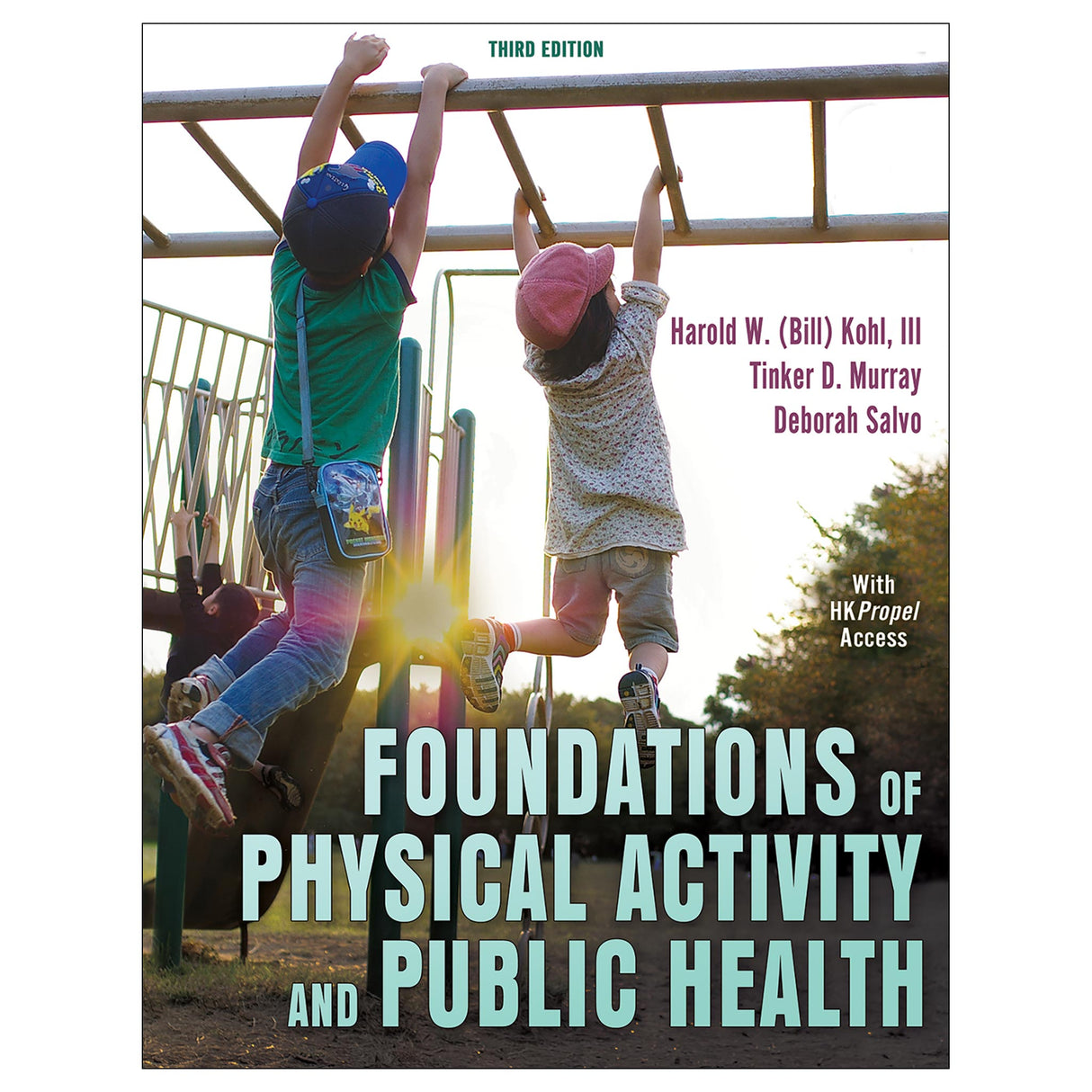Foundations of Physical Activity and Public Health 3rd Edition Ebook With HKPropel Access
$132.95 CAD

Presented in full color, Foundations of Physical Activity and Public Health uses tables, graphs, and figures to clarify complex topics, and it reflects information presented in the Physical Activity Guidelines for Americans. An underlying theme in this third edition is health equity and health disparities viewed through a physical activity lens. New sidebars devoted specifically to those topics are woven throughout the text, along with sidebars and references that have been refreshed with the latest information. Additional content updates to the third edition cover these topics:
- Brain health and immunity as they relate to physical activity and public health science
- The physical activity paradox hypothesis
- The current status of physical activity levels for children and adolescents
- Comprehensive community-wide programs to increase physical activity
Foundations of Physical Activity and Public Health will give students deeper insight into the impact of sedentary behavior and physical activity on health, including cardiorespiratory and metabolic diseases, weight status, musculoskeletal disorders, cancers, and brain health. Evidence-based strategies are examined using three general approaches—informational, behavioral and social, and environmental and policy—and examples of successful programs are showcased. A chapter on data collection and analysis describes strategies to measure and evaluate program and policy effectiveness, while discussion of real-world initiatives illustrates developing effective partnerships and models for advocacy.
As the emphasis on physical activity as a tool for improving public health grows, professionals with combined knowledge of both public health and exercise science will be highly sought. Foundations of Physical Activity and Public Health, Third Edition, will help students obtain an overview of kinesiology and public health areas, understand physical activity applications for public health, and learn about career options.
Note: A code for accessing HKPropel is included with this ebook.
Audience
Textbook for undergraduate and graduate courses in physical activity and public health; reference for public health professionals, health promotion specialists, and exercise scientists interested in physical activity and health.Chapter 1. Fundamentals of Public Health
Defining Moments in Public Health
Areas of Specialization in Public Health
Core Functions of Public Health
Public Health Law
Chapter 2. Fundamentals of Kinesiology
The Field of Kinesiology
Kinesiology Subdisciplines and Exercise Training
Principles of Exercise Training, Prescription, and Planning
Applying Physical Activity and Exercise Training Principles
Health and Fitness Benefits of Physical Activity and Exercise
Chapter 3. Integrating Public Health and Physical Activity
History of Physical Activity and Public Health
Role of Physical Activity in Chronic Disease Development
From Science to Practice and Back
Promoting Physical Activity for Health
Practitioners of Physical Activity in Public Health
Chapter 4. Measuring Physical Activity
Evidence-Based Recommended Levels of Physical Activity for Health
Laboratory Measures of Energy Expenditure
Electronic Devices to Measure Physical Activity
Direct Observation Techniques
Self-Report Instruments
Surveillance in Populations
Combining Measurement Approaches
Part II. Health Effects of Exercise and Physical Activity
Chapter 5. Cardiorespiratory and Metabolic Health
Prevalence of Cardiovascular Disease
Risk Factors for Cardiovascular Disease
Kinesiology and Cardiorespiratory Health
Cardiorespiratory Fitness Assessments
General Recommendations for Cardiorespiratory Health
Prevalence and Economic Costs of Metabolic Disease
Metabolic Disease Risk Factors
Kinesiology and Metabolic Health
Common Tests of Metabolic Function
General Recommendations for Metabolic Health
Chapter 6. Overweight and Obesity
Caloric Balance
Prevalence of Obesity and Overweight and Associated Health Consequences
Obesity and Overweight Risk Factors
Obesity and Overweight Challenges
Kinesiology and Body Weight
Common Assessments of Obesity and Overweight
Physical Activity Guidelines for a Healthy Weight
Chapter 7. Musculoskeletal and Functional Health
Prevalence of Musculoskeletal Disorders and Related Health Challenges
Risk Factors Associated With Musculoskeletal Disorders and Associated Health Challenges
Kinesiology and Musculoskeletal Health
Common Tests of Musculoskeletal Fitness or Function
Physical Activity and Musculoskeletal Health
Functional Health
Risk Factors for Poor Functional Health
Common Tests of Functional Health
Fitness Recommendations for Functional Health
Chapter 8. Cancers
Prevalence of Cancers
Cancer Risk Factors
Kinesiology and Cancers
Physical Activity Among Cancer Survivors
Physical Activity Guidelines for Cancer Prevention
Chapter 9. Brain Health and Other Emergent Health Topics
Prevalence and Economic Costs of Brain Health Disorders
Common Brain Health Conditions
Risk Factors Associated With Brain Health Disorders
Physical Activity and Brain Physiology
Physical Activity and Brain Cognitive Function
Physical Activity Guidelines for Brain Health
Physical Activity and Infectious Disease and Immune Response
Chapter 10. Health Risks and Unintended Consequences of Exercise and Physical Activity
Musculoskeletal Injuries
Kinesiology and Musculoskeletal Injuries
Sudden Adverse Cardiac Events
Part III. Strategies for Effective Physical Activity Promotion
Chapter 11. Key Resources and Theoretical Models for Evidence-Based Physical Activity Promotion
Ecological Models of Health Behavior
The Community Guide
Eight Investments That Work for Physical Activity
Selecting the Most Appropriate Source of Information
Chapter 12. Individual and Interpersonal Approaches for Promoting Physical Activity
Rationale for Informational Approaches
Behavioral Theories and Theoretical Models of Behavior Change
Social Support for Health Behavior Change
Social Support Interventions to Increase Physical Activity Participation
Individually Adapted Health Behavior Change Programs
Chapter 13. Approaches to Promoting Physical Activity in Educational Settings
Rationale for School-Based Physical Activity Programs
International and National Trends in Youth Physical Activity Levels
Kinesiology and Physical Activity Outcomes for Youth
Physical Fitness Assessments of Youth
Evidence-Based Educational Physical Activity Approaches That Work for Youth and Young Adults
Developmental Considerations for Physical Activity in Youth
Chapter 14. Community-Wide Approaches for Promoting Physical Activity
Community-Wide Informational Campaigns
Multicomponent Community-Wide Programs
Chapter 15. Environmental and Policy Approaches to Promoting Physical Activity
Access
Urban Design
Measuring the Built Environment
Physical Activity Policy
Land Use Policy
Co-Benefits of Activity-Promoting Environments and Policies
Chapter 16. Program and Policy Evaluation for Physical Activity and Public Health
Ways to Measure Program and Policy Effectiveness
Logic Models for Physical Activity Promotion and Policies
Evaluation Designs
Data Collection and Analysis
Disseminating Results
Chapter 17. Partnership Development and Advocacy
Key Factors in Building Partnerships
Strategies for Physical Activity Advocacy
Electronic devices used in physical activity surveillance and public health research
Physical activity recommendations for metabolic health
Ways to measure public health program and policy effectiveness




All ancillaries are free to adopting instructors through HKPropel.
Instructor guide. Includes a syllabus and course design suggestions along with tips, outlines, objectives, summaries for each chapter, and answers to review questions. Also features a semester-long group project, three core assignments aligned with the three parts of the text, and three assignments for students seeking a Physical Activity and Public Health Specialist certificate from the Physical Activity Alliance.
Test package. Contains more than 500 questions in true-false, fill-in-the-blank, essay and short-answer, and multiple-choice formats. The files may be downloaded for integration with a learning management system or printed for use as paper-based tests. Instructors may also create their own customized quizzes or tests from the test bank questions to assign to students directly through HKPropel. Multiple-choice and true-false questions are automatically graded, and instructors can review student scores in the platform.
Chapter quizzes. Contains ready-made quizzes to assess student comprehension of the most important concepts in each chapter. Each quiz may be downloaded or assigned to students directly through HKPropel. The chapter assessments are automatically graded, and instructors can review student scores in the platform.
Presentation package. Features more than 330 PowerPoint slides of text, artwork, and tables from the book that can be used for class discussion and presentation. The slides in the presentation package can be used directly within PowerPoint or printed to make handouts for students. Instructors can easily add, modify, and rearrange the order of the slides.
Image bank. Includes most of the figures and tables from the text, sorted by chapter. These can be used in developing a customized presentation based on specific course requirements.
Instructors also receive access to all student materials in HKPropel. For Foundations of Physical Activity and Public Health, Third Edition, this includes a key term activity, three core assignments that align with the three parts of the book, and three assignments relevant to students seeking a Physical Activity and Public Health Specialist certificate from the Physical Activity Alliance. Downloadable review questions for each chapter and web links are provided to enhance student learning.





